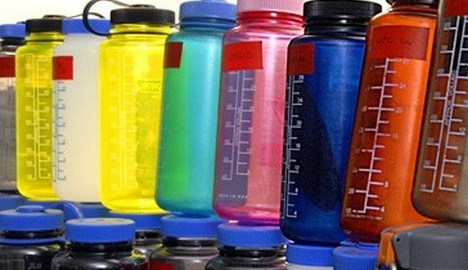Worried about Endocrine Disruptors or Mercury? Expert Argues that Coverage of Health Risks Often Fail to Tell Us What We Really Need to Know

In a post today, risk communication expert and AoE guest contributor David Ropeik focuses on how journalists covering common health risks such as mercury in fish or endocrine disruptors in plastics often “fail to tell us what we need to know to make informed choices for ourselves and for society.” His piece is re-posted with permission from the Columbia Journalism Review’s Observatory blog, one of the top outlets for tracking trends and issues in science and environmental journalism–Matthew Nisbet
There is a hidden danger in this modern world of unprecedented plenty and healthier, longer lives: our growing fears about the modern technologies that make our longer and healthier lives possible.
There are indeed real risks that accompany the benefits of industrial chemistry, mass agriculture, nuclear power, etc. But the news media tend to report those risks in a way that emphasizes the most worrisome aspects, while downplaying facts and quotes that would put the risk in a fuller, but less frightening light. Some recent coverage of Bisphenol A (BPA) presents one example of the potential damage that can come from coverage of risk that fails to tell us what we need to know to make informed choices for ourselves and for society.In mid-October, the Canadian government declared BPA a toxin. In less than twenty-four hours, The New York Times, The Washington Post, the Associated Press, Reuters, and most major news sources had reported the story. But just a few weeks earlier, the European Food Safety Agency, after reviewing 800 of the most recent studies on BP—the same science the Canadians looked at—had said that the Total Daily Intake threshold they had set in 2006 was still sufficient to protect public health. Essentially, the Europeans found that low-dose exposure to BPA is not harmful, a different view than the Canadians took. (One EFSA panelist agreed with the group’s overall decision, but suggested making the Total Daily Intake threshold temporary, pending future research.)
Guess who carried that story. Practically nobody. Not The New York Times, or The Washington Post, or The Associated Press. Reuters did, but practically none of the major news organizations that brought us the worrisome news from Canada reported on the same story when the news about BPA was reassuring. (An article in The Washington Post that included a brief, buried quote mentioning the EFSA study a month after it came out doesn’t even come to close to having “covered it.”)
There is good reason to worry about BPA and endocrine disrupting chemicals in general, and I’m proud to say I covered these stories several times back in my days as a daily environmental journalist in Boston, before the issue of endocrine disruption had caught on. But BPA is just one example of a larger trend—an alarmist, “if-it-scares-it-airs” imbalance in the way the news media cover risk stories in general.
Here’s another example. A 2007 study in The Lancet, “Maternal Fish Consumption Benefits Children’s Development,” on the risks and benefits of pregnant women eating seafood, found that the fats in the fish do more good for the cognitive health of the developing fetus than the harm—to the cognitive health of the developing fetus—done by mercury in the seafood. In other words, mothers-to-be who avoided eating seafood to protect their fetuses from mercury did more harm to the brains of their developing children than if they had eaten the fish.
How did The New York Times, The Associated Press, or most of the other major news sources around the world cover TheLancet study? They didn’t! There are lots of important facets to the mercury story. The public never heard about this one. How are pregnant moms supposed to make an informed decision equipped with only the scary half of the story? What damage might such selective coverage do—real damage, possibly greater damage than the mercury—to the cognitive development of unborn children, the very harm that restrictions on mercury are intended to prevent?
The selective coverage of the EFSA and Canadian developments regarding BPA and the near-total neglect of the Lancet study are clear failures of journalism, and should be unacceptable to news consumers who want to know enough to make a reasonably informed judgment. But this isn’t about mercury, or BPA, or any specific risk, so much as it’s about the harm such coverage can do.
Incomplete or imbalanced and alarmist information can lead directly to harmful decisions—like a pregnant mother who, to protect her unborn child, foregoes seafood because she is unaware of the potential cons and pros of eating certain species of fish. Fear of vaccines contributes to reduced immunization rates and the return of nearly eradicated diseases. Fear of processed milk leads some to choose raw milk despite the vastly increased likelihood of illness or death from pathogens. Moreover, selectively alarmist coverage can harm us just by making us worried. In a contest between stress and BPA or mercury, stress is far and away the greater risk
[Hundreds of studies associate stress with increased cardiovascular disease, the number one killer in the developed world, and increased likelihood and severity of a wide range of diseases, including cancer, since chronic stress weakens the immune system. A lot of that research is summarized in “Why Zebras Don’t Get Ulcers” by Robert Sapolsky. Is there any research, etc. that we could link to in support of this statement?].
The more worried we are, the worse it is for our health. The stress from alarmism is a risk all by itself.
Coverage of the potential dangers of modern technological and scientific progress, with minimized mention of the associated benefits, also contributes to mistrust about progress and science themselves. Genetically modified food, nuclear power and other applications of radiation, new products for the pharmaceutical industry…they all have tradeoffs. But when we hear more about the risks than the benefits, the dangers focus our attention. Attention may be good for readership and ratings and getting your story on the front page or to lead the newscast, but it’s not journalism that helps us make informed choices.
And journalism that emphasizes that “The Sky is Falling!” sends us running for the safety of the cave in how we live our lives. Worried, we buy guns, and live in gated communities, and fear “others”, and raise our kids differently for fear of the false ‘epidemic’ of child abduction, and demand government protection from the things that scare us (billions spent on hazardous waste) rather than from some things that may not sound the same level of media alarms but which threaten us much more (radon).
Most newsrooms have policies, formal or informal, about doing no harm. TV stations, for example, don’t do live reports of everybody on a ledge threatening to jump to their death, for fear of inviting copycats. Responsible news organizations that learn of things that might compromise national security, or put people or troops at risk, are circumspect with that information.
This sense of responsibility must expand. While we need the news media to keep us informed of the dangers we face, coverage of risk-related subjects has to do a more complete and honest job of reporting the scary facts and key information that may not be as alarming, or may even be reassuring. The risks of modern living are legitimately scary enough on their own without having selectively worrisome coverage feed our growing fear of progress and modern living, which, along with its risks, also offers great benefits.–Guest post by David Ropeik, reposted with permission from the Observatory Blog at the Columbia Journalism Review.
[Disclosure: David Ropeik was an environmental reporter for a TV station in Boston for twenty-two years and a board member of the Society of Environmental Journalism for nine. He was subsequently the press officer for a group of scientists at the Harvard Center for Risk Analysis that led an independent panel review of BPA science, which found that the fears at that time (2004) weren’t supported by the bulk of the evidence, and he wrote the press release for that study. He is now a consultant in risk perception and risk management for a wide range of government, corporate, academic, and civic organizations worldwide. A full list of his clients is available at www.dropeik.com. He is also founder of the program “Media Coverage and Risk”, an in-house training program for newsrooms, and author of “How Risky Is It, Really? Why Our Fears Don’t Always Match the Facts.”]





